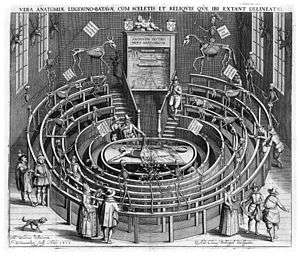Anatomical theatre


An anatomical theatre (latin: Theatrum Anatomicum) was an institution used in teaching anatomy at early modern universities.
The theatre was usually a room of roughly amphitheatrical shape, in the centre of which would stand the table on which the dissections of human or animal bodies took place. Around this table were several circular, elliptic or octagonal tiers with railings, where students or other observers could stand and get a good view of the dissection almost from above and unencumbered by the spectators in the rows in front. It was common to display skeletons at some place in the theatre; in Leiden, 17th-century depictions show that the living observers were actually accompanied in the rows by a large number of animal and human skeletons, some of which held banners with inscriptions such as Memento mori, or, freely translated, "Remember, you will die".
The first anatomical theatre was built at the University of Padua in 1594 and is still preserved. Other early examples include the Theatrum Anatomicum of Leiden University, built in 1596 and reconstructed in 1988, and the Anatomical Theatre of the Archiginnasio in Bologna (whose building dates from 1563 and the anatomical theatre from 1637).
The anatomical theatre completed in 1663 by medical professor and amateur architect Olaus Rudbeck for the University of Uppsala is located in the idiosyncratic cupola which Rudbeck placed on top of the Gustavianum building, at the time the main building of the university. Rudbeck had spent time in Leiden, and both the anatomical theatre and the botanical garden he founded in Uppsala in 1655 were influenced by his experiences there. Today Gustavianum is open for the public under the name Museum Gustavianum.
Thomas Jefferson built an anatomical theatre for the University of Virginia. It was completed in 1827 but demolished in 1939 after the construction of Alderman Library nearby.
 Anatomical theatre in Museum Boerhaave Leiden (2010)
Anatomical theatre in Museum Boerhaave Leiden (2010) The anatomical theatre at Leiden University in the early 17th century
The anatomical theatre at Leiden University in the early 17th century A modern anatomical theatre that uses projections on a body model, in the exhibit of the MUSME museum in Padua.
A modern anatomical theatre that uses projections on a body model, in the exhibit of the MUSME museum in Padua.
See also
External links
- "Anatomical Theatre". CTSNet: The Cardiothoracic Surgery Network. Archived from the original on May 19, 2006. Retrieved December 15, 2005. - A model of the anatomical theatre in Padua
- "Anatomical Theatre". CTSNet: The Cardiothoracic Surgery Network. Archived from the original on May 19, 2006. Retrieved December 15, 2005. - Engraving of the anatomical theatre at Leiden University.
- "The history of Bologna University's Medical School over the centuries. A short review.". Acta Dermatovenerologica Alpina, Pannonica et Adriatica. Archived from the original on 3 December 2005. Retrieved December 15, 2005. - with an image of the Renaissance anatomical theatre at the Bologna University
- "Digging in the Dirt". Decweb. Retrieved December 15, 2005. - has a section on Jefferson's anatomical theatre
- "Anatomical Theatre". Institute for Advanced Technology in the Humanities. Retrieved December 15, 2005.